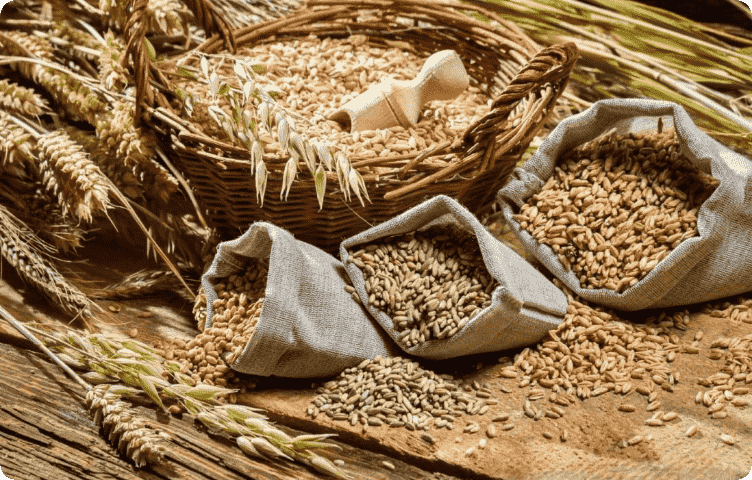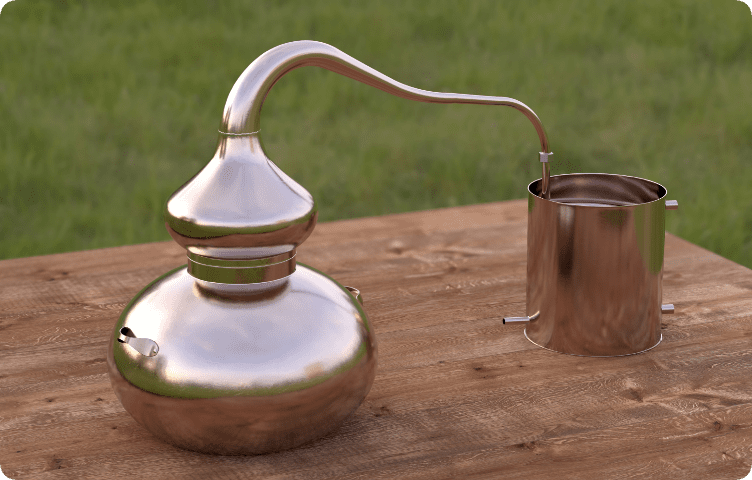Polugar is the progenitor of modern vodka. This is a product that in Rus' was called “bread wine”. Polugar is a distillate obtained by distilling grain mash in copper stills. Polugar has a pronounced bready taste and aroma, and the strength varies from 38% to 39%.
The history of polugara
Ivan Krylov, Vissarion Belinsky, Alexei Konstantinovich Tolstoy - all these great artists glorified polugar in their works: “And, too, it’s too much to admit, I sipped polugar with my friends” 1825.
It is known from historical sources that the distillation process in Rus' was used already in the 16th century; fermented wine was distilled and drinks of increased strength were obtained. And what this “wine” was made from is also not difficult to guess; the main agricultural products in Rus' were cereals, the fertile lands produced a lot of rye, oats and millet until the beginning of the 20th century. Consequently, what grew well was distilled. If, when such a cereal distillate was ignited, exactly half of its original volume burned out, then it could safely bear the name “Polugar.” And in 1842, by decree of Nicholas I, the first standard for the production of polugars was introduced.
At the end of the 19th century, Russian alcohol production completely switched to distillation columns and a ban on traditional distillation was introduced, and consequently, the production of polugar went into oblivion. And only in 2010, the Rodionov and Sons company revived the tradition of polugara and released a whole line with the brand of the same name.

What types of polugara are there?
The classic and most famous is rye polugar . It is quite soft and has a bright bready aroma. It is produced from malted and unmalted rye.
Malt half-gar . Made from 100% rye malt.
Wheat polugar . Made from malted and unmalted wheat. It has pronounced notes of field herbs and honey flowers.
Polugar rye-wheat . Made from a mixture of cereals, sometimes with the addition of malt. The taste of this drink is slightly less intense, but very harmonious.
Buckwheat polugar . It is made from buckwheat and, in addition to the aroma of buckwheat porridge, it has hints of fresh baked goods and buckwheat honey.
Polugar barley . Malted and unmalted barley are mixed, water and yeast are added and the fermentation process begins, which ends in copper columns, wisely cutting off the heads and tails.
You can also now find a whole line of half-gars with additives in the form of herbs, roots, berries and spices.
How polugar is prepared
The basis for polugars, as already mentioned, is cereals. They are used to make mash - cereals are mixed with purified water and yeast. Under the influence of yeast, sugars (contained in grain) are decomposed into carbon dioxide, impurities and ethyl alcohol. Then the mash is placed in distillation cubes and, using triple distillation, a drink with a pronounced aroma of the original raw material is obtained. Next, the drink is purified with egg whites and a carbon filter, stabilized for several days and bottled.

How is polugar different from vodka?
There is no need to confuse polugar with vodka, firstly because of the production method: vodka is rectified alcohol diluted to the required strength, and polugar is triple distillation in a pot still; and secondly because of the completely different taste and aroma profile. If vodka is quite neutral, that is, it does not have a pronounced taste or smell, then polugar sets a recognizable, unique bready aroma and rye aftertaste.
Is it possible to make homemade polugar?
It is impossible to prepare vodka at home, because its production requires rectified alcohol with a strength of 96%. But half-gar is quite real. Having pot still and the necessary ingredients available, all that remains is to experiment with taste.
















































/https%3A%2F%2Fcomplexbar.com%2Fimages%2Fblog%2F243%2Fpolugar_glavn.jpg)
/https%3A%2F%2Fcomplexbar.com%2Fimages%2Fblog%2F246%2Funiforma-barmena.jpg)
/https%3A%2F%2Fcomplexbar.com%2Fimages%2Fblog%2F246%2Fkak-nanyat-barmena.jpg)
/https%3A%2F%2Fcomplexbar.com%2Fimages%2Fblog%2F246%2FMadler.jpg)
/https%3A%2F%2Fcomplexbar.com%2Fimages%2Fblog%2F246%2F2024-04-09_17.22.54.jpg)
/https%3A%2F%2Fcomplexbar.com%2Fimages%2Fblog%2F246%2F2024-04-09_17.22.47.jpg)
/https%3A%2F%2Fcomplexbar.com%2Fimages%2Fblog%2F246%2FCODE_anons_foamydrops_752%D1%85480_eng.jpg)
/https%3A%2F%2Fcomplexbar.com%2Fimages%2Fblog%2F246%2FAlina_752%D1%85480_eng.jpg)
/https%3A%2F%2Fcomplexbar.com%2Fimages%2Fblog%2F246%2F2024-04-09_17.23.22.jpg)
/https%3A%2F%2Fcomplexbar.com%2Fimages%2Fblog%2F246%2F2024-04-09_17.23.28.jpg)
/https%3A%2F%2Fcomplexbar.com%2Fimages%2Fblog%2F246%2F2024-04-09_17.23.35.jpg)
/https%3A%2F%2Fcomplexbar.com%2Fimages%2Fblog%2F246%2Fdrinksome_752%D1%85480_eng.jpg)
/https%3A%2F%2Fcomplexbar.com%2Fimages%2Fblog%2F246%2Fnude_752%D1%85480_eng.jpg)
/https%3A%2F%2Fcomplexbar.com%2Fimages%2Fblog%2F246%2F752%D1%85480_eng__1_.jpg)
/https%3A%2F%2Fcomplexbar.com%2Fimages%2Fblog%2F246%2F752%D1%85480_eng.jpg)
/https%3A%2F%2Fcomplexbar.com%2Fimages%2Fblog%2F246%2FStudioRaw_752%D1%85480_eng.jpg)
/https%3A%2F%2Fcomplexbar.com%2Fimages%2Fblog%2F246%2FDoppio_tea_752%D1%85480_eng.jpg)
/https%3A%2F%2Fcomplexbar.com%2Fimages%2Fblog%2F246%2FTognana_Stars_Stripes_752%D1%85480_eng.jpg)
/https%3A%2F%2Fcomplexbar.com%2Fimages%2Fblog%2F246%2FRona_752%D1%85480_eng.jpg)
/https%3A%2F%2Fcomplexbar.com%2Fimages%2Fblog%2F246%2FDoppio_vending_752%D1%85480_eng.jpg)
/https%3A%2F%2Fcomplexbar.com%2Fimages%2Fblog%2F246%2FEssence_sukhie_smesi_752%D1%85480_eng.jpg)
/https%3A%2F%2Fcomplexbar.com%2Fimages%2Fblog%2F246%2FODK_sukhie_smesi752%D1%85480_eng.jpg)
/https%3A%2F%2Fcomplexbar.com%2Fimages%2Fblog%2F246%2Funiforma-barmena.jpg)
/https%3A%2F%2Fcomplexbar.com%2Fimages%2Fblog%2F246%2Fkak-nanyat-barmena.jpg)
/https%3A%2F%2Fcomplexbar.com%2Fimages%2Fblog%2F246%2Fsirop_scale_2400.jpeg)
/https%3A%2F%2Fcomplexbar.com%2Fimages%2Fblog%2F246%2FPeugeot_Anons_Paris_U%27Select_Line_Daman_752%D1%85480_eng.jpg)
/https%3A%2F%2Fcomplexbar.com%2Fimages%2Fblog%2F246%2Fkofe-vostochniy.jpg)
/https%3A%2F%2Fcomplexbar.com%2Fimages%2Fblog%2F246%2FMadler.jpg)
/https%3A%2F%2Fcomplexbar.com%2Fimages%2Fblog%2F246%2Fprofbartender_glavn.jpeg)